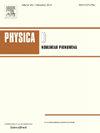离散非线性Schrödinger方程中暗孤子和亮孤子的指数渐近性
IF 2.9
3区 数学
Q1 MATHEMATICS, APPLIED
引用次数: 0
摘要
研究了强耦合条件下Schrödinger晶格中孤子的存在性和线性稳定性。聚焦和散焦非线性被考虑,产生明亮和黑暗孤子。在这种情况下,晶格离散性的影响变得指数小,需要进行全阶分析。为此,我们利用指数渐近法导出了孤子解,并系统地检验了它们的稳定性。我们证明了只有两种对称性相关的孤子构型是允许的:以晶格点为中心的局域孤子和位于相邻点之间的局域孤子。虽然由实特征值对引起的点间孤子的不稳定性在数值上是已知的,但一个严格的分析解释,特别是对于暗孤子,一直缺乏。我们的工作填补了这一空白,产生了与数值计算相匹配的高精度分析预测。我们还建立了现场亮孤子的线性稳定性。虽然该方法不能直接解决现场暗孤子的四重奏特征值引起的不稳定性,因为连续光谱覆盖了整个虚轴,我们推测了一个支持其不稳定性的特征值计数论点。总的来说,我们对指数渐近方法的应用显示了这种方法在离散非线性系统中解决多尺度问题的通用性。本文章由计算机程序翻译,如有差异,请以英文原文为准。
Exponential asymptotics of dark and bright solitons in the discrete nonlinear Schrödinger equation
We investigate the existence and linear stability of solitons in the nonlinear Schrödinger lattices in the strong coupling regime. Focusing and defocusing nonlinearities are considered, giving rise to bright and dark solitons. In this regime, the effects of lattice discreteness become exponentially small, requiring a beyond-all-orders analysis. To this end, we employ exponential asymptotics to derive soliton solutions and examine their stability systematically. We show that only two symmetry-related soliton configurations are permissible: onsite solitons centered at lattice sites and intersite solitons positioned between adjacent sites. Although the instability of intersite solitons due to real eigenvalue pairs is known numerically, a rigorous analytical account, particularly for dark solitons, has been lacking. Our work fills this gap, yielding analytical predictions that match numerical computations with high accuracy. We also establish the linear stability of onsite bright solitons. While the method cannot directly resolve the quartet eigenvalue-induced instability of onsite dark solitons due to the continuous spectrum covering the entire imaginary axis, we conjecture an eigenvalue-counting argument that supports their instability. Overall, our application of the exponential asymptotics method shows the versatility of this approach for addressing multiscale problems in discrete nonlinear systems.
求助全文
通过发布文献求助,成功后即可免费获取论文全文。
去求助
来源期刊

Physica D: Nonlinear Phenomena
物理-物理:数学物理
CiteScore
7.30
自引率
7.50%
发文量
213
审稿时长
65 days
期刊介绍:
Physica D (Nonlinear Phenomena) publishes research and review articles reporting on experimental and theoretical works, techniques and ideas that advance the understanding of nonlinear phenomena. Topics encompass wave motion in physical, chemical and biological systems; physical or biological phenomena governed by nonlinear field equations, including hydrodynamics and turbulence; pattern formation and cooperative phenomena; instability, bifurcations, chaos, and space-time disorder; integrable/Hamiltonian systems; asymptotic analysis and, more generally, mathematical methods for nonlinear systems.
 求助内容:
求助内容: 应助结果提醒方式:
应助结果提醒方式:


